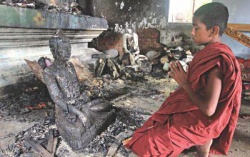Memorization
The Practice of Memorization
Most monks… start their careers when they are young (between six and twenty).2 Their first task is to memorize a large number of rituals. Memorization typically proceeds as follows. Every day, the young monk memorizes a fixed and gradually increasing amount of textual material. Usually he starts with a couple of sentences, gradually increasing to one side or both sides of a folio. Some become memory virtuosi, able to memorize five or even ten folios a day.3 In the evening, the student meets with his teacher, who examines him on the material learned that day and gives him a new piece. The teacher recites the piece, making sure that the student knows exactly how to read the passage. This precision in reading is particularly important for mantras.4 Though they are in Sanskrit, they are written in the Tibetan alphabet. Hence, they are difficult to read. The teacher’s reading is quite important: it is considered a form of transmission (lung) and authorizes the student to work on the text. Most Tibetan monks insist on the importance of such transmission (though not all agree). Once the teacher is satisfied, the student is ready for the next day’s memorization.
After rising and doing the usual chores, such as cleaning his room or that of his teacher, the young monk sits down cross-legged on a bed or on a cushion on the ground and performs a few devotional recitations; in particular he invokes Mañjuśrī, the patron bodhisattva of wisdom. This invocation ends with the syllable dhīḥ, the sonic seed of this bodhisattva, which is repeated as many times as possible in a single breath: dhīḥ, dhīḥ, dhīḥ, dhīḥ… Such repetition is thought to increase the intellectual faculties and hence to help one memorize. The young monk then proceeds to memorize the passage given to him the night before. He loudly reads it from his text bit by bit, rocking his body back and forth. He starts with the first word or two of the first sentence or line of a stanza (often but not always the text is written as poetry; the verses of seven, nine, or eleven syllables, grouped in four-line stanzas, are easier to retain than prose), reciting that element until he has mastered it. He then moves on incrementally until he has memorized the whole sentence, which he recites, still in a loud voice, several times. The same process is repeated for subsequent sentences; and after memorizing each, he recites the sentences that he has just memorized. Thus, by the end of the session, the whole passage forms a whole that can be integrated with the passages he has already memorized.
The process of memorization is aural. Without relying on visual mnemonic devices, Tibetan monks memorize their texts by vocalizing them. The only support is a tune to which the words are set. In certain monasteries (such as Namgyel, where monks are expected to memorize an enormous amount of liturgical material), the text is memorized to the same tune to which it is later chanted. In scholastic monasteries or in smaller monasteries, there is no fixed tune. But in both cases, students concentrate entirely on the text’s sonic pattern, ignoring other associations as much as possible.5
If the whole day is devoted to memorization, the session is often finished around noon, just before the young monk has lunch (often with his teacher). The afternoon is taken up in various ways, depending on the wishes of the teacher, the age of the student, the day of the month, the type of institution, and so on. Some teachers are quite strict and closely watch their pupils, who have to spend most of the afternoon reciting what they have memorized. Others allow greater freedom. At the Namgyel monastery in India, monks memorize new material in the morning and recite earlier lessons through the whole afternoon and evening. Rgan Blo bzang rgya mtsho [Dreyfus’s principal teacher at the Dialectic School in Dharamsala, India) had a much easier time: his first teacher was very a kind man who did not keep tight discipline. Genla would spend the afternoon playing with other young monks, unless there was some special event (a full-day liturgical service) or a specific task to be done.
The evening is spent practicing the texts previously memorized. The student starts by reciting that morning’s passage several times, until his recitation is fluent and almost effortless. He then goes back to the parts of the same text learned on preceding days, ending with the passage learned the same day. He may add other texts learned previously. This exercise, which usually takes one or two hours, is essential to ensure that passages once memorized are not forgotten. At first, the passage newly memorized, which could be recited quite fluently in the morning, comes in the evening with difficulty, if at all. It needs to be fixed again in the memory, a task best done just before the student goes to sleep. After a night of sleep, the text starts to take its fixed form, which has to be constantly strengthened until it becomes ingrained—a process that takes many days of repetition. In this way, the student’s hold on previous passages increases, and the new passage is integrated gradually into the memorized text as a whole. It is only when the texts are so well learned that they come to mind automatically that frequent recitation is no longer needed. At that point, reciting them a few times a year can keep them alive in the monk’s memory.
In the evening, the young monk being trained in memorization faces the biggest ordeal of the day: the dreaded exam on that day’s passage. The student enters the teacher’s room and hands over the passage he has been working on. He then sits or squats at the feet of his teacher, who is seated on his bed (the usual position of most Tibetans when they are at home), and repeats the passage by heart. Sometimes the teacher asks him to recite previously learned passages. Any mistake is immediately punished. Some teachers hit their students for any mistake. An error in pronunciation might draw a single stroke, but a failure in memory could lead to a more serious beating. Genla was lucky; his teacher, who was also a relative, was kind toward his students. Others are much less pleasant, and there are even some sadists who brutalize their students. Once the exam is over, the cycle starts again with the transmission of a new passage to be memorized the next day.
This process of memorization is practiced not only by monks and nuns, but also by laity. Most laypeople recite religious texts every day and often memorize the briefer ones, using the same technique described here. The memorization of such texts relies only on sound. A friend of mine reported that when he was a child, his parents made him memorize the maṇḍala offering, a text recited in which one offers a symbolic representation of the to the universe to the deity worshipped or the guru. It describes the objects to be offered: the sun (nyima), the moon (dawa), the precious umbrella (rinpoché duk). My friend, however, understood these to be the names of people and thought the text referred to Mrs. Sun, Moon, and Rinpoché being there (duk).
Tibetan Monasteries: Islands of Peace, or Oceans of Noise?
The centrality of sound in Tibetan monastic life, about which I will have more to say, is obvious to anybody who has stayed in any large Tibetan monastery. As I have stressed, a Tibetan monastery is devoted not to meditation but to rituals and sometimes studies. Far from being an island of peace and quiet like a hermitage, it is filled with activities and almost constant noise. It is, in Anne Klein’s words, “an arena suffused with sound.”6
The day often starts with a chanted ritual service done on behalf of a sponsor. It continues with the cacophony of memorization, as each monk loudly repeats a different passage to his own rhythm and tune. Later on, further ritual services or sessions of debate may be conducted, while the young monks who have not yet finished their preliminary memorization keep reciting their texts at the top of their transmissions. It is only at lunchtime that relative quiet descends on the monastery. After eating, monks relax. Friendly chats take place here and there, but loud discussions are frowned on. There is usually less noise during the first part of the afternoon, when fewer monks memorize and many either read or engage in the different tasks that have been assigned to them. But the noise picks up during the evening, when the main sessions of debate are held. Then the air is filled with the roar from the debating courtyard. When debates end, monks start their recitation sessions, as described above. At this point, hundreds of monks may be reciting as loudly as they can, and the cacophony can reach an almost unimaginable level. Around ten the noise diminishes, and by eleven only scattered recitations can be heard. There are times, however, when some monks decide to spend the whole night reciting. Religious festivals such as the full moon of the fourth Tibetan month, which commemorates the Buddha’s enlightenment as well as his passing away, are often chosen for such exercises. At these auspicious times, the practice of virtue is considered much more effective.
Reading or reciting aloud is considered virtuous for several reasons. Vocalizing a text in a rhythmic pattern helps it penetrate one’s mind, where it starts to take on a life of its own. One finds oneself spontaneously repeating the words. Such absorption of religious texts is thought to have soteriological value. The virtuous nature of recitation is also tied to a view of the world as alive with a number of invisible entities. Traditional Tibetans believe that countless gods and spirits live around us in trees, springs, houses, and rocks. Loud recitation attracts these entities, who are then able to hear the Buddhist teaching (an opportunity usually denied by their birth); hence, it is thought to be a highly meritorious form of giving (jinpa, dāna). Geshé Rabten recalls matter-of-factly,
There was a cemetery not far from our monastery; it was inhabited by many spirits and other non-human forms of life. It is said in the scriptures that if one recites kind words of dharma in the direction of such a place, it benefits these creatures. Thus, moved to be of service to them, at night when I was reciting I would sometimes turn towards this cemetery, and in a loud voice chant some fine verses of dharma.7
Tibetans therefore view loud recitation as valuable in and of itself. It helps other sentient beings, particularly if it is aesthetically pleasing.8
A small incident illustrates the religious value of recitation and its sometimes unexpected results. During the 1960s, Trijang Rinpoché visited the three monastic seats then located at Buxa in Northeast India. One of the Dalai Lama (tā la’i bla ma)’s tutors, he was an extremely famous teacher and the guru of most of the Geluk monks. Students are supposed to please their guru by offering them their services as well as presents, and the best offering is one’s virtuous practice. What better way to rejoice Rinpoché than a highly virtuous action such as a full-night recitation? Or at least so a young monk thought. Thus, he positioned himself near Rinpoché’s room and proceeded to spend the whole night reciting at full volume all the texts he had ever memorized. Rinpoché’s reaction, alas, was not what he had expected. “Who is the idiot who kept me awake the whole night?” was his reported comment. Most Tibetan monks, however, are much less sensitive to disturbances than was Rinpoché, and they carry on their normal activities, including study or sleep, in the greatest uproar.
Still, one may wonder about the utility of all this noise. Doesn’t it interfere with the learning process, much as the faithful disciple’s loud recitation prevented Trijang Rinpoché’s sleep? The counterintuitive answer is that the noise of monasteries in fact supports and reinforces the learning process – particularly memorization. Monks report that far from being distracted by the sounds of other monks’ memorizations, they find them helpful to their own practice. Learning is not just individual but interpersonal as well. When students hear each other, their energy and focus are reinforced. They are supported by the feeling of participating in a common task and pushed to memorize more than they might on their own. At times, a kind of competition develops in which students try to outlast each other, vying to produce the last tune to be heard.
Memorization and Liturgical Discipline
Memorization is an important element of the disciplinary practices on which Tibetan monasticism rests. It integrates monks into the monastic community by enabling them to take part in the monastery’s collective rituals, which are its central activities. On entering a monastery, the young monk must first memorize its liturgy (chöchö), which is of two types. The exoteric liturgy contains a few short sūtras (such as the Heart Sutra), confessional texts, prayers in the proper sense of the word (mönlam), and devotional practices such as the Seven-limb worship. The esoteric liturgy comprises a large number of tantric texts as well as the texts necessary to propitiate the protectors.
The centrality of these liturgical practices varies from monastery to monastery. In those specializing in liturgical services, such as the Tantric Monasteries and Namgyel, ritual is the main activity. The liturgy of these monasteries includes hundreds of folios whose memorization requires several years of extremely demanding effort. The knowledge of new monks is tested: on a number of occasions they must recite the entire liturgy of the monastery in front of their peers. They are also sometimes examined privately by the higher authorities, who may deliberately disrupt the recitation in order to see how deeply ingrained a monk’s memorization is. A friend from Namgyel recalls that the Dalai Lama suddenly entered the room where he was reciting. Not content with just listening to the recitation, the Dalai Lama proceeded to scratch my friend’s back to test if his memorization was unshakable. Despite the considerable emotion provoked by this gesture, my friend did not lose his concentration and was able to continue to recite flawlessly.
In smaller monasteries like Rgan Blo bzang rgya mtsho’s, the requirements are usually less stringent, and the life of a young monk memorizing the liturgy can be quite pleasant, provided that his teacher is not too harsh. By the age of seventeen (he had started at eleven), Genla had finished the first part of his task. He had memorized the exoteric part of the liturgy, presumably together with the rituals of propitiation. Having finished the bare minimum of memorization, he was ready to go on to the next step: a three-year visit to one of the three monastic seats.
In the monastic universities, liturgy plays a less important role (relatively speaking). Accordingly, in these institutions less time and effort are spent on memorizing liturgical material. Nevertheless, only after mastering this liturgy are monks admitted as full members of the monastery, able to take part in scholastic activities.9 Thus, memorization of liturgical texts is a basic practice of Tibetan monasticism. Unlike scholarly training, which is undertaken only by a small minority through many years of intense dedication, memorization is the province of all the monks. It inculcates in them a sense of discipline central to the monastic enterprise as they follow a daily routine under the supervision of an authority. They start the day with an assignment from their teacher and end it with the teacher’s examination of that same task. This cannot help but greatly strengthen the sense of obedience that young monks develop toward their teachers – a sense particularly reinforced by the ordeals of the daily examination, and the possible punishments associated with it. But memorization’s most important disciplinary role is that it forms monks into efficient members of the ritual community. Rituals can be performed well only when they are properly memorized and recited uniformly by all monks to the same tune and rhythm. This uniformity creates a powerful effect that satisfies performers and supporters alike. The monks can feel confident of the religious power or value of such practices, and sponsors, in turn, feel justified in their support of the monastery.
The Role of Memorization in the Curriculum
Memorization is the first step in any traditional Tibetan monastic career, and initially it is practiced almost to the exclusion of other activities. It continues for those monks who wish to pursue higher monastic studies, for the curriculum is structured around the study of a few basic texts committed to memory. Unlike studies at modern institutions, which are organized according to disciplines, scholastic studies are organized around important writings – the great Indian treatises (tenjö, śāstra), the root (tsawa, mūla) texts... It is the study of these texts that constitutes the tradition.
These texts are assimilated through commentaries and debates, which themselves are not memorized. Instead, students memorize the root texts, which are written in short, mnemonic verses. The commentaries and debates are retained not verbatim but in relation to the memorized root text. That text provides a nondiscursive template around which ideas that might otherwise seem disconnected can fall into place, enabling students to organize explanations and objections. The memorization of a root text thus contributes not only to the retention of information but also to the accessibility of the information retained. Psychologists distinguish between free recall, in which subjects attempt to recall as many random items as possible, and the cued recall of items organized by rubrics. Their experiments indicate that cued recall is more effective.10 For the students, the memorization of base texts provides the rubric needed for cued recall, enabling them to recall topics more easily.
Students are also expected to memorize a certain amount of commentarial material. Some memorize entire commentaries, amounting to hundreds or even thousands of pages. These commentaries can provide decisive arguments during a debate. They also supply models for the students, helping them to gradually assimilate the highly technical and precise commentarial style and procedures. Nevertheless, learning root texts by heart is much more important, for sharp students are able to reason persuasively without quoting texts. Similarly, they can rely on their own understanding to comment on texts – but only if they have mastered the root text, which provides the structure according to which knowledge is organized and stored.
This educational process reflects the belief that knowledge needs to be immediately accessible rather than merely available.11 That is, scholars must have an active command of the texts that structure the curriculum, not simply the ability to retrieve information from them. Knowing where bits of information are stored is not enough: the texts must inform one’s thinking and become integrated into one’s way of looking at the world. Geshé Rabten emphasizes the importance of an active knowledge based on memorization, which he contrasts with the approach he observed among his Western disciples: “Although it was difficult at first, I, like other monks, gradually became accustomed to it [i.e., recitation], so that both memorization and recitation came with ease. In the Western academic tradition, note-taking plays a vital role, and much of one’s knowledge tends to be confined between the covers of one’s textbooks [or notebooks]. Our corresponding stores of knowledge were held in our mind through memorization.”12 When texts are held in mind, their deeper meaning becomes apparent and the knowledge they convey becomes active and useful. Otherwise, one merely has scattered bits and pieces of information. It is only through memory that these pieces can be combined to provide actual knowledge.
Hence, memorization cannot be divorced from learning. It enables the monks to fully assimilate the content of the texts they study. As William Graham explains, “The very act of learning a text ‘by heart’ internalizes the text in a way that familiarity with even an often-read book does not. Memorization is a particularly intimate appropriation of a text, and the capacity to quote or recite a text from memory is a spiritual resource that is tapped automatically in an act of reflection, worship, prayer or moral deliberations.”13 In the Tibetan scholastic context, as noted above, quotations can supply effective arguments within a debate; commentaries can be particularly useful to corner an adversary and demonstrate the mistakes in his interpretation. It is also significant that some of the memorized texts have spiritual relevance. But by far the most important role of memorization, especially of the root texts, is to provide the organizational structure of the whole curriculum.
The cultivation of memory is central to Tibetan monasticism in general and scholasticism in particular. As Mary Carruthers has argued in a study of medieval Europe, reliance on memory is characteristic of traditional education; modern societies, in contrast, are primarily documentary. Tibetan monks memorize texts in order to internalize their content, not because of their scarcity. Printing has existed for several centuries and although texts were not always abundant, they were far from rare. Hence, memorization is not just the result of material conditions, or the survival of a practice once dictated by such conditions. The medievalist Jean-Claude Schmitt notes, “Nothing is outlived in a culture, everything is lived or not. A belief or a rite is not the combination of residues and of heterogeneous innovations, but experience that has meaning only in its present cohesion.” 14
[2] A few individuals become monks at an advanced age (after forty or fifty). Such people, who are called genchö (i.e., “[those who practice] dharma in their old age”), are considered second-class monks and are not expected to memorize very much; often they are accepted in monasteries only if they can provide for themselves.
[3] Traditional Tibetan books are not bound; the loose pages contain five to seven long lines, printed from wood blocks. Tsongkhapa is said to have been able to memorize up to seventeen folios a day. See Cha har dge bshes blo bzang tshul khrims, Rje thams cad mkhyen pa tsong kha pa chen po’i rnam thar go sla bar brjod pa bde legs kun kyi byung gnas)] in The Collected Works (gsung ’bum) of cha har dge bshes lo bzang tshul khrims, vol. 2 (Kha) (New Delhi: Chatrin Jangsar Tenzin, 1971), 104.
[4] A basic premise in Indian and Tibetan cultures is that a mantra is fully effective if, and only if, it is pronounced exactly right. This requirement, which goes back to Vedic culture, is viewed by Tibetans with some flexibility and even humor. They know that they do not read mantras in the same way that Indians do. Nevertheless, they have kept the old injunction requiring precise pronunciation. On the general theory of mantra, see H. Alper, ed., Mantra (Albany: State University of New York Press, 1989).
[5] To be sure, the memorizers look at a page, thereby introducing a visual dimension. Changes in the appearance of that page (e.g., in a different edition) can disturb the process, a sign that visual patterns contribute to memorization. But a completely memorized text becomes fully sonic. Sometimes the memorizer relies solely on the spoken words of the teacher, a practice that eliminates any visual dimension. It is less common, however, for it is time-consuming.
[6] Anne Klein, comp., trans., and ed., Path to the Middle: Oral Madhyamika Philosophy in Tibet (Albany: State University of New York Press, 1994), 6.
[7] Geshe Rabten, The Life and Teaching of Geshé Rabten: A Tibetan Lama’s Search for Truth, trans. and ed. B. A. Wallace (London: Allen and Unwin, 1980), 81.
[8] The example of the Indian master Sthiramati (fifth century C.E.) is often cited to demonstrate the value of recitation. He was a dove when he listened with reverence to Vasubandhu’s melodious recitation. As a result he was reborn as a human being and shortly after his birth he started to inquire about Vasubandhu’s whereabouts. See Tāranātha’s History of Buddhism in India, trans. Lama Chimpa and A. Chattopadhyaya, ed. D. Chattopadhyaya (1970; reprint, Calcutta: Bagchi, 1980), 179-80.
[9] José Cabezón, “The Regulations of a Monastery,” in Religions of Tibet in Practice, ed. Donald Lopez (Princeton: Princeton University Press, 1997), 351.
[10] R. G. Crowder, Principles of Learning and Memory (Hillsdale, N.J.: Erlbaum, 1976), 9.
[11] For a distinction between accessibility and availability, see Crowder, Principles of Learning and Memory, 11.
[12] Rabten, The Life and Teaching, 53. A Sanskrit proverb puts it this way: “As for knowledge that is in books, it is like money placed in another’s hand: When the time has come to use it, there is no knowledge, there is no money.” (quoted in W. A. Graham, Beyond the Written Word: Oral Aspects of Scripture in the History of Religion, Cambridge: Cambridge University Press, 1987, 74).
[13] Graham, Beyond the Written Word, 160.
[14] J.-C. Schmitt, “Religion populaire et culture folklorique,” Annales: Economies, sociétés, civilizations 31 (1976): 946; quoted in Bernard Faure, The Rhetoric of Immediacy: A Cultural Critique of Chan/Zen Buddhism (Princeton: Princeton University Press, 1991), 89.










